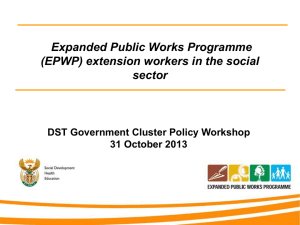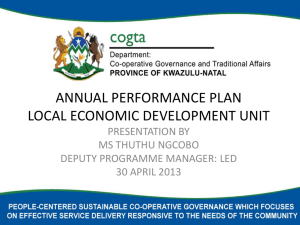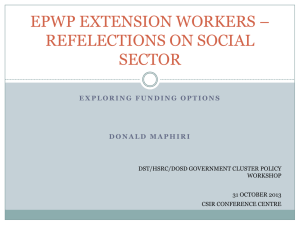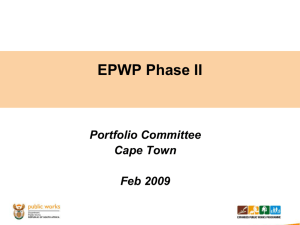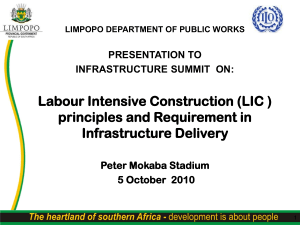EPWP Phase III Enterprise Development Policy Framework
advertisement
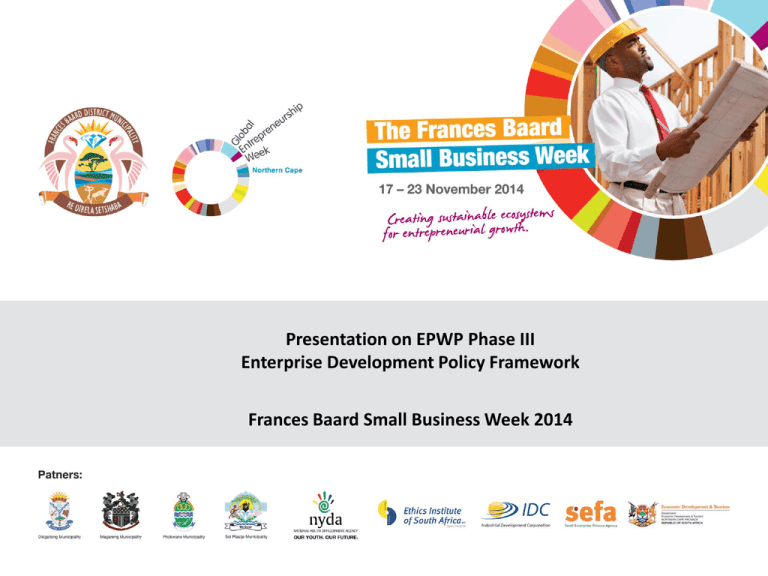
Presentation on EPWP Phase III Enterprise Development Policy Framework Frances Baard Small Business Week 2014 Content of the Presentation Purpose of the presentation Background EPWP Policy Context EPWP Phase 3 Framework EPWP Target Beneficiaries Framework for developing the policy Conclusion Purpose of Presentation To explain the draft framework that has been developed by NDPW for the implementation of the enterprise development policy. This framework was endorsed by EPWP Provincial counterparts. To contextualise the importance of developing the policy. To indicate the support available to municipalities. To highlight the expectations on municipalities. Policy Context for EPWP Phase III The NDP outlines two key objectives for EPWP in that context namely: • Contribute to reducing unemployment by creating temporary employment by being responsive to the number of unemployed. “ The public employment programmes should target the creation of 2 million opportunities annually by 2020 or earlier, if possible”……. “The main opportunities will lie in community based services and the roll out of social sector initiatives” (Chapter 3) • Contribute to social protection for the unemployed by providing them with income support (Chapter 11) In the New Growth Path, EPWP is seen as an important contributor in Jobs Driver 1 (Infrastructure Development) through increasing the labour intensity of government infrastructure investments and Jobs Driver 4 (Social Capital) through expansion of the Community Work Programme. Objective of EPWP Phase III For the EPWP to be effective and achieve the vision set out in the NDP it is proposed that the EPWP has a clear and limited mandate. “To provide work opportunities and income support to poor and unemployed people through the labourintensive delivery of public and community assets and services, thereby contributing to development.” EPWP Phase III Principles Adherence to the EPWP Minimum wage and employment conditions under the Ministerial Determination (R75,10) • The EPWP Ministerial determination of 2012 sets out a minimum wage for the EPWP and the EPWP must seek to achieve full compliance with this determination. There is currently substantial non-compliance with the minimum wage. Selection of workers based on a clearly defined process and defined criteria • The selection of each worker should be done on a clear set of criteria to minimize patronage and abuse during selection and ensure target group benefits. The selection should also happen in accordance with clear transparent and fair procedures. Work provides or enhances public goods and community services • The work output of each EPWP project should contribute to enhancing public goods or community services. Minimum labour intensity appropriate to sector • A minimum labour-intensity benchmark appropriate to each sector should be set as sectors differ too much to apply a common standard across all sectors. Furthermore programmes within each sector would also be encouraged to set their own benchmarks. Targeting in the EPWP Phase III Targeting of vulnerable groups Category Phase II Targets Phase III Targets Women 55% 55% Youth between 16 and 35 40% 55% Persons with disabilities 2% 2% The 2013 National Youth Employment Accord advocates for a Youth target of 80% for Public Employment Programmes. The EPWP Phase 3 Youth Target is 55%. This will be progressively increased towards 80% for new entrants into the EPWP. 7 Targeting of Beneficiaries/Participants in the EPWP Phase III The EPWP will target the poor and unemployed through a combination of geographical and community-based targeting, as well as self-targeting (through the wage rate). Targeting to be done through a combination of: Geographical Targeting: Focus on poor communities and those with high number of unemployed Self-Targeting: Through the EPWP Minimum wage rate Community Targeting: Community selects those most in need through and based on transparent criteria and process 8 Institutional Arrangements for EPWP Phase III To achieve better synergy between our wide range of PEPs and other poverty alleviation, employment, enterprise development and skills development initiatives, Parliament adopted that: A Presidential Public Employment Coordination Committee to address Jobs and Poverty issues be established (Announced at the State of the Nation Address). The Commission is chaired by the Deputy President and meets quarterly. It is composed of relevant Ministers, nine Premiers and SALGA. It is supported by a Political Management Committee of relevant ministers, and a Political Secretariat of relevant Ministers and Deputy Ministers. The Commission has two major work streams, PEPs and Employment, and PEPs and Sustainable Livelihoods. Its technical secretariat is the DPW’s current EPWP branch, working closely with other relevant line department branches. 9 Key Change in Phase III Cabinet approved the establishment of the Presidential Public Employment Coordinating Commission (PPECC) to coordinate and report on public employment programmes with EPWP branch as Secretariat. Introduction of core universal principles. Adherence to the EPWP Minimum wage and employment conditions under the Ministerial Determination Selection of workers based on a clearly defined process and defined criteria Work provides or enhances public goods and community services Minimum labour intensity appropriate to sector Increased community participation for more visibility and ownership in poor communities. Increase scope of infrastructure maintenance. More emphasis on monitoring of assets created and their impact on communities. 10 EPWP ENTERPRISE DEVELOPMENT FRAMEWORK 11 Legislative Framework The National Small Business Act, No. 102 of 1996 as amended; White Paper on National Strategy for the Development and Promotion of Small Business in South Africa, 1995; Cooperative Amendment Act No. 6 of 2013; Integrated Strategy on the Promotion of Entrepreneurship and Small Enterprises; and EPWP related documents. Intergrated Youth Development Strategy 2012 12 ED Approach Ensuring the availability of a wide array of EPWP capacity training programmes; Ensuring a capacitated team of EPWP Enterprise Managers that are trained as trainers and mentors within municipalities; Engaging Public Bodies to identify training capacity needs; Complying with a Funded Annual Enterprise Development Business Plan and Calendar; Enterprise Developmental Files and Diagnostic Assessments as standard practice; Linkages with the DTI, NYDA and respective agencies like SEDA. 13 Eligibility Criteria Programme must be an EPWP Programme and the specific project under the Programme must have minimum duration of 12 months. The programme must provide technical and project management support. Programme must be reported in any of the EPWP reporting systems aligned to a project number. SMMEs supported should have employment contracts with their workers. Enterprise Development support has to be applied for annually, unless EPWP Enterprise Development has a partnership agreement with the Programme 14 ED Tools Diagnostic assessments Capacity building: compliance requirements; business plan and profile development; human resource and staff management; financial matters such as banking, access to finance and insurance; Market opportunity such as how to access markets, tendering, registering on supplier databases; Inventory matters such as how to procure materials and equipment and how to manage stock levels; and business administration, which includes record keeping and basic contract administration. Coaching and mentoring. Exploring the idea of an SMME fund 15 Institutional Arrangement Each municipality to establish an Enterprise Development Management Forum/ Committee: Participants: All programmes supported by ED i.e. Programme Coordination; Lead Sector Departments of all EPWP sectors; Provincial Enterprise Development Departments; and NDPW ED (EPWP). Role: (1) Report quarterly on Enterprise Development interventions ito annual plan. At National level, ED reports performance to National sector meetings, the NCC and NT. 16 Applicability and Revision Policy is applicable to all EPWP initiatives that have ED intention; Wide consultation to include: National, Provincial and Local spheres, EPWP Sectors; Selected programmes; Other stakeholders and partners: EDD, NT, DTI, etc. Applicable during Phase III and will be revised as and when the needed. 17 Municipal Technical support • The Municipal Technical Support programme will continue to focus on providing assistance to municipalities to use labourintensive methods as they implement their projects. • The sub-programme will work on institutionalisation of EPWP approaches in municipalities by ensuring that Tender documents, consultants and contractors are aligned to the requirements of EPWP. • Training of officials and consultants in labour-intensive methods will continue to be carried out. It is critical to build capacity at municipal level to implement projects labourintensively. 18 Vuk’uphile • The programme continues to focus on the training of contractors and supervisors in labour-intensive methods of construction. • Increased emphasis is placed on ensuring that the projects implemented through Vuk’uphile contractors are model LI projects, with high labour intensities so that they can demonstrate the use of these methods. • A stronger focus is on using Vuk’uphile to build the capacity of public bodies to implement EPWP projects in future. • Continue implementing improvements: – Practical training on LI construction in a risk free environment so that they are not pre-occupied with managing overall project risk and ensuring profitability, while they are still learning about LI construction methods – Keep project below R 10 million – Build commitment of Public Bodies to LIC 19 Conclusion Endorsement of Policy The policy must be endorsed by the Council to ensure that it is binding and everybody comply. Review of the Policy The policy will be reviewed after 2 years or as and when required 20 Development Corridors 21 Q&A 22 TSS Contact Details • Tshiamo Dichabe • Mobile: +2783 878 5580 • tshiamo@blackjills.co.za Ke a leboga!! 23
